Savoring Soave II. The Wineries and the Wines
Bruno Trentini, general manager of Cantina di Soave, handed me an envelope and said, as a joke, that it did not contain soldi (money). “But take it anyway because it is something you will enjoy.”
I assumed (which is always a mistake) that the other journalists in our group had received the same letter and when I went up to my room I put it away and forgot about it.
On Sunday we were going to the Castello Scaligero in Soave to attend a ceremony and induction into the Imperial Castellania Di Suavia, a worldwide women’s organization that praises “il Vino Bianco Soave”. The members are persons who love good wine and good food. When we arrived, we found a band of costumed musicians playing medieval music and a coordinated flag throwing demonstration. Many attendees also wore Medieval attire.
Three Italian women were being inducted into the organization when Jonathan, the organizer of the trip, whispered in my ear to ask, “Can you make a short thank you speech in Italian?” Before I could ask him what for, I heard my name being announced
and very nice things being said about me. As I made my way toward the stage I realized that the Society was inducting me as “Capitano Spadarino”, protector of the Women and of the Castle for my contributions to Italian wine and food and Soave in particular. They presented me with a spadarino, or short sword on an embroidered sash. That was what the letter in the envelope would have explained if I had taken the time to read it. Yes, I did thank them in Italian and it is all on tape!
One of the highlights of my visit to Soave was a tasting in a vineyard arranged by Giovanni Ponchia, the enologist from the Soave consortium and our guide. We tasted 20 wines while looking at the vines growing on the Pergola Veronese. The wines were Soave Classico and Soave Classico Superiore and all single vineyards. The first 14 were Soave between tuff (a type of rock made from volcanic ash or dust) and basalt (volcanic rock, fine-grained that is usually black in color) and the last 6 Soave in black soil and white soil. We had detailed maps which showed where the vineyards for each wine were located and aerial photos of each site. They really are into terroir and how it affects the wine. I was very impressed by the high quality of the wines. These are the ones I liked the most:
Soave Superiore Classico “Foscarin Slavinus” 2007 Monte Tondo- 100% Garganega. Soft pressing and maceration on the skins for 24 hours- fermentation with the skins for 36 hours-fermentation in 50hl casks- aged in stainless steel tanks for one year and in bottle for 6 months months. $30
Soave Classico DOC “Casette Foscarin” 2007 90% Garganega and 10% Trebbiano Soave. The vineyards are in the North of the Soave Classico zone in calcareous soil of volcanic origin. The grapes most exposed to the sun are chosen and harvested at different times according to ripeness. The wine is soft pressed and aged in barriques and 5hl tonnellerie for about 6 months. $22
Soave Superiore Classico “Capitel Al Pigno” 2006 Bixio Produttori – 100% Garganega- The wine is aged 3 months in large casks and 4 months in bottle.
Soave Classico “Corte Menini” 2009 Le Mandolare – 100% Garganega- traditional vinification without the skins, on the lees for 4 months in stainless steel tanks.
Soave Classico “Vigneto Senglialta” 2008 Balestri Valda Garganega and Trebbiano di Soave. The wine is aged in 20hl Slavonian oak.
Soave Classico “Frosca” 2008 100% Garganega. Gini Hillside vineyard with soil that is part calcareous and part tufaceous. The grapes are soft pressed and fermented in both stainless steel and wood. It remains on the lees in stainless steel and wood and is then ages in small oak barrels.
Soave Classico “Salvarenza” 2007- 90% Garganega and 10% Trebbiano Soave. Grapes are from 90 year old vines from a part of the Frosca vineyard called Salvarenza. The grapes are harvested at the end of October which makes them almost late harvest. Fermented entirely on the lees in barriques of which 20% are new. The wine remains in wood for 9 months.
What made visiting the wineries so interesting was that each one had something unique to show, tell or to taste. I also noticed that some of the wineries had olive or cherry trees planted near the vines depending where the winery was located. Almost all of them had spontaneous cover crops and grass cover between the rows of vines.
Cantina di Monteforte is a large cooperative that produces a wide range of wines including “wine in the box”. They gave us three wines to taste blind and then wanted us to rank them. I tasted the wines and said they could be the same, but no one answered me. After we voted we were told it was the same wine only the closure was different, cork, glass and synthetic cork. I could not tell much difference between the three wines. The wine closed with cork did come in #I. I like the glass closure but some producers were reluctant to use it because they were afraid it might crack and the glass would go in the bottle.
The wine I liked the best was the Clivus Soave Classico made from Garganica and Trebbiano di Soave from volcanic soil in the hilly area of the Monteforte d’Alpone district. The grapes are soft pressed and fermented in stainless steel.
Ca’Rugate This is a family owned and operated winery. The Tessari family has owned vineyards in this area for four generations and opened this winery in1986. We were given a tour of the winey and the “Enomuseum” by Federica Bon. The museum is very interesting and worth a visit. The setting is a farm house of the late 1940’s and there are over 150 instruments and tools used by the Tessari family over the last 100 years for winemaking from the time the grapes enter the barnyard to the aging and bottling.
Federica then led us in a tasting of the wines and I was impressed with all of them:
Soave Classico “San Michele” 2009- 100% Garganega $20 Next year they will add Trebbiano di Soave so that it will be different from their Soave Classico “Monte Fiorentine” which is also 100% Garganega. $30. Both vinified and aged in stainless steel.
Soave Classico “Monte Alto” 100% Garganega $39 The wine is vinified in stainless steel and the fermentation takes place in barriques (225 liter oak barrels) where it remains on the lees between 6-8 months.
Recioto di Soave DOCG 100% Garganega. The grapes are dried in plastic boxes in special “drying rooms” were the grapes become very concentrated. The spring following the harvest the grapes are crushed and fermented in oak barrels and aged in these barrels for 10-12 months.
Once again in order to demonstrate the importance of terroir, at Azienda Agricola i Stefanini, we tasted three wines. Next to each was a container of the soil in which the vines were planted. Francesco Tessari, the owner of the winery, and Giovanni Ponchia explained the soil and its relationship to the wine.
IL Selese Soave DOC the wine is usually 90% Garganega and 10% Chardonay but the 2009 is 100% Garganega. The soil is alluvial clay, the vines are trained in the Espalier system and the vineyard is in the flat lowlands. This was from the part of the valley with red soil, “Terra Rosa”. Fermentation takes place on the lees until March in stainless steel, and under goes partial malolatic. It is kept in stainless steel until bottling.
Soave Classico DOC Monte di Toni 2008 100% Garganega, the vineyards are in the volcanic hills behind the winery. The soil is volcanic tufa, the average age of the vines is 25 years and they are trained in the Pergola Veronese system. It is fermented and aged on the lees until March in stainless steel and under goes complete malolatic fermentation.
Soave Superiore Classico DOCG “Monte di Fice” 2006 100% Garganega the vineyards are in the volcanic hills behind the winery. The soil is volcanic tufa. The wines are an average of 25 years old and are trained on the Pergola Veronese. It is fermented on the lees until March and under goes partial malolatic fermentation. Even though the two vineyards are a few meters apart, the Toni had more calcareous uplift stratum and the Fice is more ferrous volcanic soil.
Az. Ag Monte Tondo. This is a family owned winery. The proprietor is Gino Magnabosco along with his wife and daughter Marta, who conducted the tasting, run the winery.
Soave Classico Superiore DOCG “Foscarin Slavinus" We did a vertical of this wine from 2003-2009. Monte Foscarino is basaltic origin and the slopes are very steep. The wines were all very good but the one that caught my attention was the 2004. I asked if I could buy some to take back with me but was told it was not for sale.
Recioto di Soave DOCG 100% Garganega This is a selection of the best grapes with the highest sugar content. The grapes are handpicked and left to semi-dry in small crates and in well ventilated rooms called fruttai. At the end of January the grapes are pressed and left to age for 18 months in small oak barrels.
Recioto Soave Spumante DOCG “Round Mountain” 2008 100% Garganega from the Soave Classical area. I do not think I have ever tasted this type of wine before. It is only made in small quantities. The grapes used are those most exposed to the sun with the highest sugar content. They are handpicked into small crates and dried in rooms called fruttai. The wine is stored in stainless steel for 90 days after undergoing the Charmat Method to obtain a sparkling wine. This was a very interesting wine.
Of all the wineries that we visited perhaps the most interesting was Cantina di Soave in the town of Soave in a very lovely setting where there Borgo Rocca Sveva facility is located. This large cooperative makes Borgo Rocca Sveva, their top of the line brand right, down to Duca their wine in a box, and everything in between. The Company was founded in 1898 and today has over 2,200 members which make it one of Europe’s major wine producing companies. They give excellent winery tours open to the public and have a large retail store where you can buy wine and other products.
We went to visit the vineyards with the agronomist from Cantina di Soave and he explained how the coop works with the growers, the control they have over how the grapes are grown and, of course, all about the terroir and the different training systems for the vines. They use all the latest modern methods in the vineyards, “Sistema Alta Selezione”, and are able to register the origin, health, quality level and variety for every batch of grapes delivered to the winery. We were given aerial photos of the section of the vineyards we visited. There were many olive trees planted near the vineyard and we were told that it was customary in this area. Everyone connected with the winery was very helpful and gave us information not only about the winery but about Soave and the Veneto in general
Soave Classico DOC 2008 Borgo Rocca Sveva – 100% Garganega. The vines are planted in loose, medium-gravelly clay soil of volcanic origin. The wines are trained for the Pergola Veronese system. The grapes are soft pressed and fermented and aged in stainless steel. $14.99
Their wine in the box, Duca del Frassino, was the best one I tasted.
Cantina del Castello – It is in heart of Soave just below the Scaligero Castle. While they have been making wines since the 1960’s it was not until Arturo Stocchetti took over 20 years ago that the winery reached its true potential. Arturo is very charming and has a passion for wine that you can feel when he speaks. He always wants to produce typical wines that express the terroir in which the vines are planted. Arturo is also the president of the Consorzio Tutela di Soave. He is very well known for his sweet wines and is a Recioto specialist. He makes two Recioto di Soave- Recioto di Soave Classico DOCG “Cortepittora” – 100% Garganega from the Pressoni vineyard of clayey basaltic soil of volcanic origin in the Monteforte d’Alpone zone. The grapes are hand harvested and dried in well ventilated rooms until Jan/Feb then undergo soft pressing and fermentation in Allier oak barrels, medium toast, 4 to 5 years old. It is aged in the same barrels for one year then aged in bottle for 1 to 2 years before it is released.
Recioto di Soave Classico DOCG “Ardens” 100% Garganega. Training system is the pergola Veronese semplice and short espalier. Manual harvesting into small crates in a single layer. Dried in well ventilated rooms until Jan/Feb, very soft pressing with a 35% must yield. Fermentation is stainless steel for 30 to 40 days. The wine is “cleaned” by decanting which is the traditional method. The wine is bottled in May/June after a mild filtration that allows a natural refermentation “sur lie” in the bottle-the wine is on the lees until it is consumed. The wine spends 7to 8 months in the bottle before it is released. I understand why Arturo is a Recioto specialist now that I have tasted his wines.
Fattori winery Soave Classico “Danieli” the owner Antonio Fattori said that this was a family nickname. 100% Garganega from hillside vineyards of volcanic soil. Maceration for 36 hours, gently pressed with a pneumatic press. The wine is left for 24 hours and after static decantation the wine is fermented in stainless steel.
Soave Classico “Runcaris” 100% Garganega. The average age of the vineyard is 25 years, in volcanic soil and the vines are trained in the Pergola Veronese system. Vinification and fermentation in stainless steel. Signore Fattori said that it was traditional to use 10% of late harvested grapes. He also said that they use nitrogen to control the fermentation process but do add a small amount of sulfites during the static decantation and bottling.
Soave DOC “Motto Piane” 100% Garganega. This wine borders on desert with a residual sugar content of 6.5 gl. The average age of the vines is 30 years. Guyot trained. Harvesting begins the second week of September and the grapes are handpicked. They are dried on straw mats for about a month. Maceration is for 24 hours. The must is fermented in stainless steel until alcohol reaches 2%. It is then put in large casks, tonneaux, and stainless steel to age. The wine remains on its lees until February and is bottled the following spring.
Reciotto di Soave DOCG “Motto Piane”(Flat Hill) 2008 100% Garganega. Vines planted on hill of volcanic origin and cordon speronato trained. The grapes are dried until the following March. They lose 50% of their weight and the sugar content is 33%, then the grapes are macerated for 72 hours. The must is decanted naturally and yeast is added. Stainless steel tanks are only used when the fermentation process is under way. It then goes into barriques until the alcohol level reaches 14 to 14.5. The wine contains 9 grams of sugar per liter which Signor Fattori believes is perfect. The wine is reracked stopping the fermentation process. Then it goes back into the same barriques for 14 to 15 months.
Az. Ag. PRA Graziano We had a tour of the winery and a tasting conducted by Laura Meile followed by a lovely lunch overlooking the vineyards. Giovanni Ponchia once again went into the vineyard, this time we could watch from our seats at the table, as he talked about the soil, the Pergola Veronese, and the other training systems. All he had to do was point to what he was explaining.
Soave Classico 2008 100% Garganega Monteforte d’Alpone area and the vineyards are 25-30 years old. Vines are trained in the Pergola Veronese system and the wine is fermented and aged in stainless steel. $18.
Az.Ag Agostino Vicentini This winery was in an area called the valley of the cherries because there were so many cherry trees planted here. Agostino is very passionate about his vines and his wines. He took us out into the vineyard and spoke about the vines. He liked the Pergola Veronese because it protected the grapes from getting to much sun and “burning”. However wind can be a problem because it can break some of the canes and he showed us some examples of broken ones which he removed. Agostino believed that grapes trained by Pergola Veronese were best for Recioto di Soave but felt that Guyot was best for his other wines. All of his white wines are in stainless steel. Since he wants to let the wines reflect the terroir, there is as little interference by the winemaker as possible.
Soave Superiore DOCG “IL Casale” 100% Zone of production Colognola ai Colli. Guyot vineyard system and the grapes are picked when they are very ripe.
Recioto di Soave DOCG Zone of production Colognola ai Colli, località S. Zeno
Grapes are selected and picked by hand at 32-35 brix and put in boxes and left to dry until March. The wine contains about 110 grams of sugar.
Az. AG.Gini Sandro Gini gave us a tour of the winery and a tasting of a wines from a number of different vintages going back to a good 1993 and a sensational 1990. As I said before I was very impressed with these wines especially the La Frosca 1990, 2001,2004,2007 and 2008 and the “Salvarenza” 2001 and 2007. Sandro said that these wines need at least 3/4 years before they begin to be ready to drink.
This was one of the most informative and interesting wine trips that I have been on and I look forward to returning next year. There is a real desire in this area to make wines that reflect the terroir without relying on oak. Very few producers used new barriques, and if they did it is a small percentage. Some producers are using barriques that are 7 years old. Others only use stainless steel but the majority seems to use a mix a stainless steel, barriques, tonneaux and botti. I did not find more than one or two wines that I could say were over-oaked.






























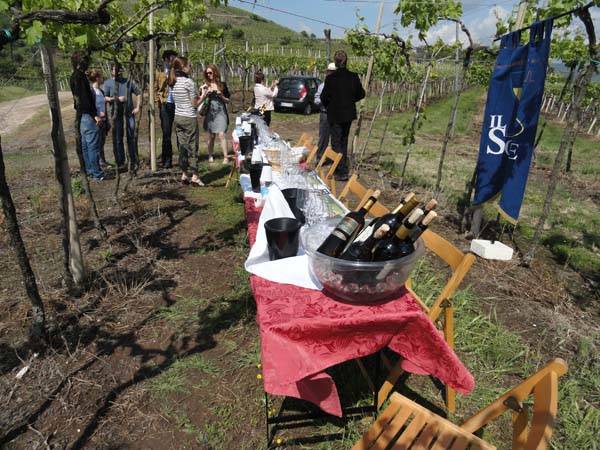


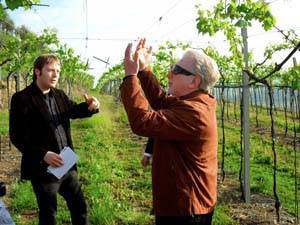
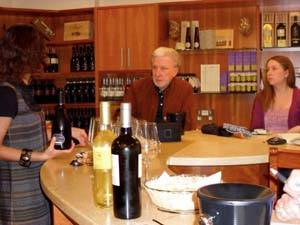
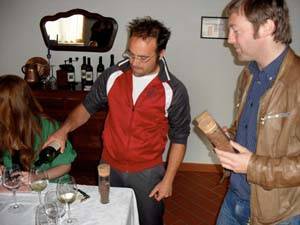

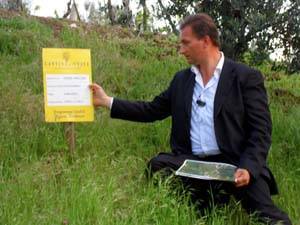
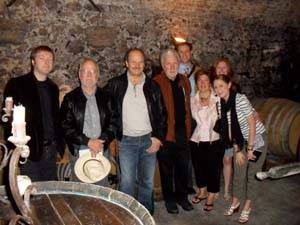
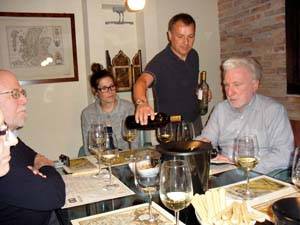
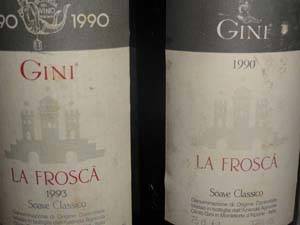



i-Italy
Facebook
Google+
This work may not be reproduced, in whole or in part, without prior written permission.
Questo lavoro non può essere riprodotto, in tutto o in parte, senza permesso scritto.